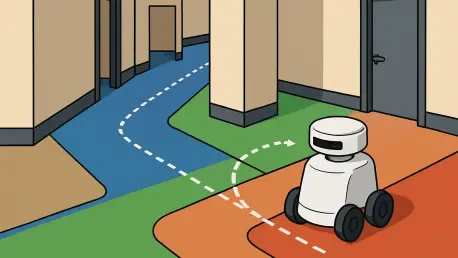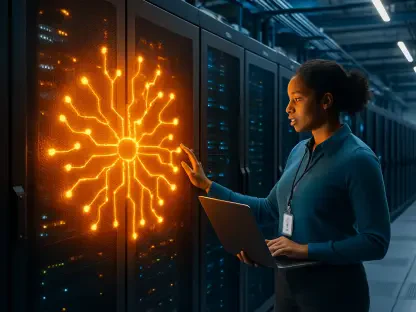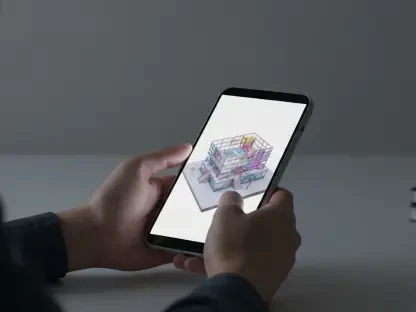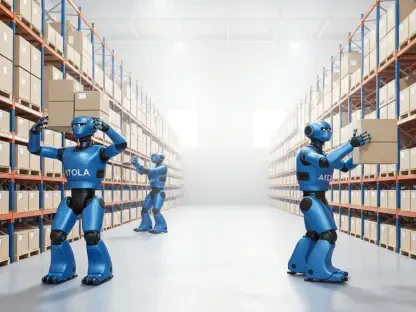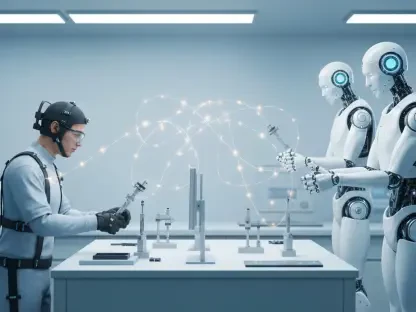Picture a hospital ward buzzing with activity, where a robot tasked with delivering critical supplies hesitates at a corridor intersection, unsure of its next move, stranded without a map or reliable GPS signal in a maze of identical hallways and shifting obstacles. This scenario underscores a persistent challenge in robotics: navigating complex indoor environments without predefined guides. The stakes are high—delayed deliveries in healthcare or stalled operations in warehouses can have significant consequences. How can technology bridge this gap and empower robots to find their way autonomously?
The urgency of this issue extends beyond isolated incidents. Indoor spaces, from offices to homes, are often unpredictable, with furniture rearranging and lighting conditions fluctuating. Traditional navigation systems, reliant on static maps, struggle to adapt, leaving robots vulnerable to errors. This article explores a cutting-edge solution driven by artificial intelligence (AI), revealing how it equips robots to navigate without maps and transforms industries dependent on automation.
Why Are Robots Struggling to Find Their Way Indoors?
Indoor environments pose unique hurdles for robotic navigation, far different from outdoor settings where GPS reigns supreme. Signals falter behind walls, and visual landmarks are often absent in sterile or cluttered spaces like hospital wings or storage facilities. Robots equipped with conventional systems frequently lose their bearings, unable to reconcile their position in real time, which can lead to operational failures or safety risks.
The absence of reliable cues exacerbates the problem. Unlike outdoor landscapes with distinct features, indoor areas may present featureless walls or repetitive patterns that confuse even advanced sensors. A robot in a warehouse, for instance, might misinterpret its location due to rows of identical shelving, resulting in costly delays. This highlights a critical gap in current technology: the inability to adapt to environments that lack consistent reference points.
Beyond technical limitations, the consequences of navigational failures are tangible. A misplaced robot in a busy setting can disrupt workflows, endanger personnel, or compromise time-sensitive tasks. As industries increasingly rely on automation for efficiency, solving this indoor navigation puzzle becomes not just a technical challenge but a necessity for progress.
The Real-World Need for Mapless Navigation
The demand for mapless navigation stems from the dynamic nature of indoor spaces, where change is constant. Furniture shifts, new obstacles appear, and lighting dims without warning, rendering pre-built maps obsolete within hours. A delivery robot in an office building, for example, cannot depend on a static layout when desks are moved or temporary barriers are erected, necessitating a system that reacts to the environment in real time.
This need is particularly pressing across diverse sectors. In healthcare, robots must transport medications through crowded wards without hesitation. In logistics, autonomous units in warehouses face ever-changing inventories and layouts. The reliance on human intervention or outdated maps in these scenarios slows operations and undermines the promise of automation, pushing for solutions that grant true independence to machines.
Moreover, the economic and operational benefits of mapless navigation are undeniable. Reducing the need for manual oversight or frequent map updates saves time and resources, allowing industries to scale robotic deployment. The drive toward autonomous adaptability isn’t just about convenience; it’s about meeting the growing expectations of efficiency in an era where technology must keep pace with complexity.
Breaking Down AI’s Role in Mapless Navigation
Artificial intelligence, particularly through deep reinforcement learning (DRL), offers a transformative approach to indoor navigation without maps. By training robots to learn from simulated environments, DRL enables them to make decisions based on real-time data rather than fixed instructions. Research from leading institutions has pioneered methods like integrating localization quality into movement choices, ensuring a robot evaluates its positional accuracy at every step.
Key innovations enhance this capability significantly. Using RGB-D cameras paired with systems like ORB-SLAM2, robots assess the visual richness of their surroundings, opting for paths with stronger cues to maintain orientation. A dynamic reward function, based on Relative Pose Error (RPE), further refines this process by providing instant feedback on positional accuracy, allowing adaptation to shifting conditions. Data from simulated tests shows a striking improvement—a 49% success rate compared to just 33% for traditional SLAM methods.
Practical examples illustrate the balance AI achieves between efficiency and reliability. Robots equipped with these systems often choose longer but safer routes to avoid areas with poor visual markers, prioritizing accuracy over speed. This strategic decision-making mirrors human judgment, marking a leap forward in autonomous navigation and showcasing AI’s potential to tackle indoor challenges head-on.
Expert Insights and Groundbreaking Results
Voices from the field lend weight to these advancements, emphasizing their real-world relevance. Dr. Ze Ji, a senior author of recent studies, notes that effective navigation hinges on robots “thinking about how well they know where they are.” This perspective shifts the focus from mere obstacle avoidance to a deeper awareness of spatial confidence, a critical factor in unpredictable settings.
Published findings in a prominent robotics journal underscore the impact of this research. Tests in simulated indoor environments reveal lower localization errors and heightened adaptability compared to conventional approaches. The numbers speak for themselves: robots using AI-driven models consistently outperform older systems, navigating complex layouts with fewer missteps and greater assurance.
A compelling anecdote brings this potential to life. Consider a service robot in a hospital ward, weaving through crowded corridors to deliver urgent supplies without a preloaded map. Such scenarios, once deemed impractical, now seem within reach thanks to these breakthroughs. The promise of seamless integration into daily operations fuels optimism among experts, pointing to a future where robots operate with unprecedented independence.
Practical Steps Toward Implementing AI-Driven Mapless Navigation
For developers and industry professionals eager to harness this technology, actionable strategies provide a clear path forward. Training robots in simulated environments like iGibson offers a realistic testing ground for indoor challenges, allowing algorithms to refine decision-making before real-world deployment. This controlled setting helps mimic the unpredictability of actual spaces, building robust navigation skills.
Another crucial step involves prioritizing localization feedback over simple obstacle avoidance. By integrating systems that analyze visual map points, robots can identify safer directions with ample cues for orientation. This approach ensures they don’t just dodge barriers but also maintain a clear sense of position, reducing the risk of getting lost in featureless zones.
Finally, adopting dynamic error thresholds enhances adaptability. Unlike rigid constraints, these flexible benchmarks allow robots to adjust to varying conditions, tolerating minor uncertainties when necessary while tightening accuracy in critical moments. Tailored for practical application, such measures equip robots to navigate unfamiliar indoor terrains with confidence, paving the way for safer and more autonomous operations across sectors.
Reflecting on a Path Forward
Looking back, the journey to mapless robot navigation indoors revealed both persistent obstacles and remarkable innovations. AI, through deep reinforcement learning, proved to be a game-changer, enabling robots to adapt to the chaos of real-world environments with newfound precision. The strides made in simulated tests, backed by expert insights, painted a picture of technology on the cusp of revolutionizing industries.
Moving ahead, the focus must shift to real-world testing in dynamic settings, where pedestrians and unforeseen variables come into play. Expanding research from simulations to physical robots over the next few years, starting from 2025, will be crucial in validating these systems. Collaboration between researchers and industry leaders can accelerate this transition, ensuring solutions are both practical and scalable.
Ultimately, the vision of autonomous robots navigating hospitals, warehouses, and homes without maps calls for sustained investment in AI development. Encouraging innovation in localization-aware systems holds the key to unlocking safer, more efficient automation. As challenges were met with ingenuity in recent studies, so too must future hurdles be addressed with determination to reshape how robots interact with the world.
